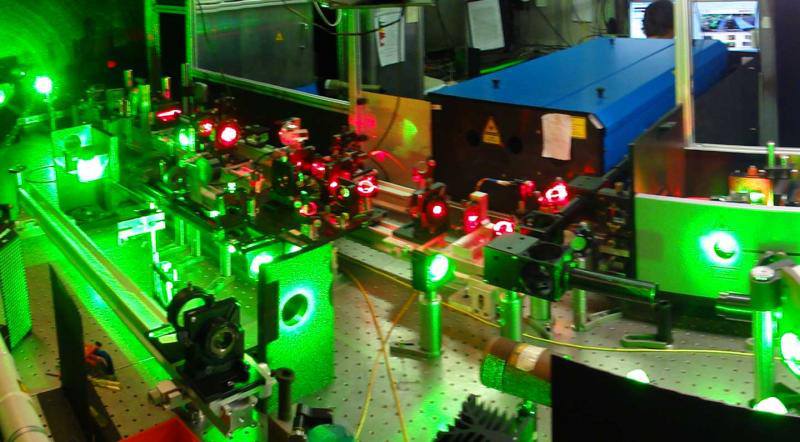Three Natures in the ISOLDE hand
The radioactive beam facility at CERN, ISOLDE(1) has pioneered many achievements both at the level of designing new devices and of producing frontier Physics. These demarches have been crowned by a series of papers in Nature and Nature communication published within a month.

The first paper was dedicated to the characterization of atomic nuclei having an unusual octupole or “pear” shape. This beautiful piece of nuclear spectroscopy work on the excited structure of the 220Rn and 224Ra was done using the unique heavy, radioactive beams from REX-ISOLDE in conjunction with the Miniball setup. The measurements, that showed that while 220Rn undergoes vibrations of the octupole mass distribution, 224Ra has a rigid pear-like shape, were published on the 9th of May [1] and the shape of 224Ra was used to illustrate the cover of the corresponding Nature issue. The results help to discriminate different models of octupole correlations and also help to identify suitable candidates for the experimental determination of sizeable values of atomic electric-dipole moments (EDM), as predicted by some theories of physics beyond the standard model. The work was done by a group of fifty physicists from the U.K., Belgium, CERN, France, Finland, Germany, Poland, Spain, Sweden and USA. The student who analysed the data, Liam Gaffney, was awarded the Institute of Physics Nuclear Physics Early Career Award for “his work on Coulomb excitation of heavy octupole nuclei.”
The following week, the 14th of May, results from experiments to determine, for the first time, the astatine ionization potential were published in Nature Communication [2]. Laser ionization spectroscopy was used to probe the optical spectrum of astatine produced in ISOLDE target. By observing a series of Rydberg states a precise value of this last missing ionization potential of the table of naturally occurring elements was obtained. This work, done in very close collaboration between the RILIS team (EN-STI-LP) in charge of the Resonance Ionization Laser Ion Source of ISOLDE and the users, constitutes a good benchmark for quantum chemistry calculations of the properties of astatine. The latter is of importance to investigate the possibilities of using astatine as a radioisotope for cancer treatment. Further this value helps predicting the ionization potential for the superheavy element Z = 117, its heaviest chemical homologue. The work was performed by a group of forty physicists from CERN, Belgium, Canada, France, Germany, Israel, Japan, New Zealand, Russia, Slovakia and U.K. The first author of this paper, Sebastian Rothe, was awarded by the Marie Curie international training network LA3NET for outstanding contribution to the field of laser applications at accelerators.

In this week's Nature issue, 20th of June, a letter was published dedicated to the determination of the mass of neutron rich calcium isotopes at the verge of existence [3]. The determination of the 51-52Ca masses was done using the ISOLTRAP Penning trap mass spectrometer and for the extremely low produced short-lived species 53-54Ca a multi-reflection time-of-flight spectrometer was designed and used for separating isobars and for the first time for mass determination. A pioneering work done at CERN thirty five years ago indicated that the magic numbers of neutron and protons corresponding to closed shells and large energy gaps established from measurements of stable nuclei could loose their special character due to the proton-neutron asymmetry. It is since then a great challenge for theory to predict the new magic numbers emerging far from stability and closely related to our understanding of the different components of the strong force that act between neutron and protons. These measurements are in excellent agreement with the predictions using three nucleon forces based on chiral effective theory and unambiguously establish N=32 as a closed shell neutron number for neutron rich nuclei very far from stability. These results help to better understand dense nuclear matter and the subtle components of nuclear forces. This work was signed by about twenty authors from Germany, CERN, Belgium, France and Turkey. In addition one of the co-authors of this work (R.B. Cakirli) was given two weeks ago, Friday 6th of June, during the Int Conf. in Nuclear Physics the award of IUPAP Young Scientist Prize “For innovative use of precise nuclear mass measurements in critical regions of the nuclear chart to access correlations which are used to extract empirical signatures of collective degrees of freedom and of shell closures. For stimulating a large body of new theoretical and experimental work in these areas”.
Further Readings:
[1] L. Gaffney et al., Nature 497 (2013) 199-204.
[2] S. Rothe et al., Nature Com. DOI:10.1038/ncomms2819
[3] F. Wienholtz et al., Nature 498 (2013) 346-349DOI: 10.1038/nature12226
Watch previous CERN Hangouts with ISOLDE:
Going pear-shaped:
The dream of the alchemists.
